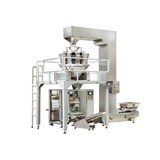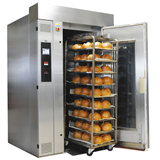In the fast-paced world of commercial kitchens, technology is continuously evolving, revolutionizing the way we cook and bake.
Among the many kitchen appliances that have seen remarkable innovations, commercial convection ovens stand out as versatile workhorses that have undergone significant transformations.
In this in-depth exploration, we dive into the latest innovations and technology trends shaping the landscape of commercial convection ovens.
From IoT-enabled ovens to advancements in heat distribution, we uncover the cutting-edge features that are enhancing user experience, improving energy efficiency, and setting the stage for a future of culinary excellence.
-
Smart and IoT-Enabled Convection Ovens
The era of smart technology has permeated nearly every aspect of our lives, and commercial convection ovens are no exception. These next-generation ovens have embraced the power of the Internet of Things (IoT), empowering chefs and kitchen staff with an array of futuristic capabilities.
Let's delve into the exciting innovations that smart and IoT-enabled convection ovens bring to the table:
- Remote Monitoring and Control: IoT integration allows chefs and kitchen managers to monitor and control convection ovens remotely. They can keep a close eye on cooking progress, adjust settings, and receive notifications via smartphones or tablets, providing unparalleled flexibility and convenience.
- Data-Driven Cooking: Smart ovens can analyze data from previous cooking cycles and adapt their settings for optimal results. By learning from past performance, these ovens fine-tune cooking parameters, ensuring consistent and precise cooking every time.
- Recipe Library and Automation: IoT-enabled convection ovens often come with a built-in recipe library. Chefs can select recipes directly from the oven's interface, and the oven will automatically set the appropriate time, temperature, and cooking mode, streamlining the cooking process.
- Energy Optimization: Through IoT connectivity, smart ovens can assess energy consumption patterns and optimize their usage. This not only reduces energy costs but also contributes to sustainability efforts by minimizing energy wastage.
- Remote Diagnostics and Maintenance: IoT integration enables these ovens to self-diagnose potential issues and send maintenance alerts to kitchen managers or technicians. This proactive approach ensures timely maintenance, minimizing downtime and maximizing efficiency.
The fusion of smart technology and convection ovens represents a significant leap forward, providing unparalleled control and efficiency for commercial kitchens.
-
Energy-Saving Features and Sustainability:
In a world increasingly focused on environmental consciousness, energy-saving features in commercial convection ovens have become a top priority for manufacturers and chefs alike. These ovens are designed with cutting-edge technology and features that not only reduce energy consumption but also contribute to sustainability efforts. Here are some of the key energy-saving innovations:
- LED Lighting: Traditional incandescent lights have been replaced by energy-efficient LED lighting in modern convection ovens. LED lights produce less heat, consume less energy, and have a longer lifespan, ensuring well-lit cooking without unnecessary energy expenditure.
- Improved Insulation: Innovations in insulation materials have significantly reduced heat loss in convection ovens. By retaining heat more effectively, these ovens require less energy to maintain the desired cooking temperature, resulting in substantial energy savings over time.
- Energy Recovery Systems: Some advanced convection ovens feature energy recovery systems that capture and repurpose waste heat generated during the cooking process. This captured heat is redirected back into the oven, reducing the overall energy needed for cooking.
- Low-Power Standby Mode: Convection ovens now incorporate low-power standby modes, which automatically activate during periods of inactivity. In this mode, the oven consumes minimal energy, ensuring it's ready for use while minimizing wastage.
- Solar-Powered Options: As solar energy continues to gain momentum, some manufacturers offer convection ovens with the option of solar-powered operation. These ovens harness the sun's energy to power their cooking functions, providing a truly sustainable cooking solution.
Sustainability-driven features in commercial convection ovens not only benefit the environment but also contribute to significant cost savings for businesses in the long run. By adopting these eco-conscious innovations, commercial kitchens can pave the way for a greener and more efficient culinary landscape.
-
Integration with Kitchen Management Systems
Efficiency and seamless coordination are paramount in a bustling commercial kitchen. The integration of convection ovens with kitchen management systems has emerged as a game-changer, streamlining operations and optimizing productivity. Here's how this integration is transforming the culinary landscape:
- Centralized Control and Monitoring: Convection ovens integrated with kitchen management systems can be controlled and monitored from a central interface. Kitchen managers can access real-time data on oven usage, cooking times, and energy consumption, allowing for better resource allocation and decision-making.
- Automated Workflows: Kitchen management systems can automate cooking workflows by communicating with convection ovens. When an order is entered into the system, the oven settings are automatically adjusted to ensure timely and consistent cooking, reducing manual errors and kitchen bottlenecks.
- Inventory Management: Integration with inventory management systems enables ovens to track cooking ingredients and quantities used. This data can be valuable in managing stock levels, reducing food waste, and optimizing menu planning.
- Data Analytics and Performance Optimization: By gathering data from convection ovens, kitchen management systems can provide valuable insights through data analytics. This information can be used to optimize cooking processes, fine-tune recipes, and identify areas for operational improvement.
- Seamless Communication with Other Appliances: Integrated ovens can communicate with other smart kitchen appliances, such as refrigerators and sous-vide machines. This interconnectivity enables a synchronized kitchen environment, where appliances work in harmony to streamline cooking operations.
The integration of convection ovens with kitchen management systems represents a significant step forward in achieving kitchen efficiency, reducing waste, and maximizing productivity in commercial settings.
-
Advancements in Heat Distribution and Control:
Even heat distribution and precise temperature control are vital for consistent cooking results in commercial convection ovens. Advancements in heat distribution and control technology have transformed these ovens, setting new standards for culinary perfection. Here are the innovations shaping this aspect of convection ovens:
- Multi-Fan Systems: Traditional convection ovens usually have one fan for heat circulation. Modern convection ovens boast multi-fan systems strategically placed to ensure uniform airflow throughout the cooking chamber. This technology eliminates hotspots and delivers even cooking results across all trays and racks.
- Variable Speed Fans: Some ovens come equipped with variable speed fans, allowing chefs to adjust the fan's rotational speed. This feature is particularly useful when cooking delicate items that require gentler heat distribution.
- Precise Temperature Probes: Advanced convection ovens now feature precise temperature probes that continuously monitor the internal temperature of food. By relaying real-time data to the oven's control system, these probes enable precise temperature control, preventing overcooking or undercooking.
- Zone Heating: Zone heating technology divides the oven chamber into separate sections, each with its own heating element and fan. Chefs can control the temperature independently in each zone, accommodating different cooking requirements simultaneously.
- Convection-Steam Hybrid Technology: Some convection ovens combine convection cooking with steam injection capabilities. This hybrid technology enhances cooking precision, especially for delicate dishes like pastries and seafood, while maintaining a moist cooking environment.
These advancements in heat distribution and control technology empower chefs with greater control over the cooking process, ensuring consistent, delicious results for a wide range of culinary creations.
-
Enhancing User Experience and Accessibility
In the rapidly evolving world of technology, user experience (UX) plays a pivotal role in the design of commercial convection ovens. Manufacturers are increasingly focused on making these appliances more user-friendly and accessible to kitchen staff of all skill levels. Here's how UX enhancements are shaping the convection oven landscape:
- Intuitive Touchscreen Interfaces: Traditional knobs and dials are giving way to sleek, intuitive touchscreen interfaces. These user-friendly displays provide chefs with quick access to cooking settings, recipe libraries, and cooking progress updates.
- Multilingual Support: In commercial kitchens with diverse staff, multilingual support in oven interfaces has become invaluable. Chefs can select their preferred language, ensuring seamless communication and operation.
- Voice Control: Voice-activated controls are making their way into convection ovens, allowing chefs to operate ovens hands-free. This feature is particularly beneficial when hands are occupied or when precise adjustments are required.
- Accessible Height and Design: Some convection ovens now feature adjustable heights to accommodate differently-abled kitchen staff. Additionally, designs with thoughtful ergonomics ensure ease of use for all users.
- Interactive Guides and Tutorials: To assist novice chefs, interactive guides and tutorials are becoming common in modern convection ovens. These step-by-step instructions simplify complex cooking techniques, empowering cooks to explore new recipes confidently.
By prioritizing user experience and accessibility, manufacturers are democratizing the culinary art, enabling chefs of all backgrounds and expertise levels to create masterpieces with ease.
-
Future Outlook for Commercial Convection Ovens
As we peek into the future of commercial convection ovens, it's clear that innovation knows no bounds. Manufacturers and technology pioneers are continuously pushing the envelope to redefine the capabilities of these kitchen workhorses. Here are some potential advancements that may shape the future of convection ovens:
- AI-Driven Cooking: Artificial Intelligence (AI) integration could take convection ovens to a whole new level. AI algorithms may analyze ingredients, cooking preferences, and dietary restrictions to suggest personalized recipes and cooking methods.
- Holographic Displays: Futuristic holographic displays may revolutionize oven interfaces, providing a more immersive and interactive cooking experience for chefs.
- Carbon Footprint Reduction: The quest for sustainability may lead to convection ovens powered by renewable energy sources or even ovens with carbon-neutral operation.
- 3D Printing Integration: The integration of 3D printing technology with ovens could open up a world of possibilities for creative culinary presentations and customized food shapes.
- Advanced Materials: Innovations in materials science may yield convection ovens made from cutting-edge, heat-resistant materials, further improving insulation and energy efficiency.
While these predictions may seem like science fiction, the relentless pursuit of excellence in culinary technology will undoubtedly bring forth exciting and groundbreaking advancements in commercial convection ovens.
In conclusion, the landscape of commercial convection ovens is experiencing a profound transformation fueled by innovation and technology. Smart and IoT-enabled ovens bring remote monitoring, data-driven cooking, and energy optimization to commercial kitchens, revolutionizing the way chefs operate. The industry's commitment to sustainability is evident through energy-saving features, improved insulation, and energy recovery systems, all contributing to a greener future.
Integration with kitchen management systems streamlines operations and enhances productivity, while advancements in heat distribution and control ensure consistent, delectable results. User experience enhancements, such as intuitive touchscreen interfaces and voice control, empower chefs of all skill levels to unleash their creativity. As we glimpse into the future, the potential for AI-driven cooking, holographic displays, and other cutting-edge innovations presents a tantalizing vision for the culinary world.
The journey of innovation in commercial convection ovens is far from over. As technology continues to evolve, we can expect to witness even more remarkable advancements that will redefine the art of cooking, offering unparalleled possibilities and experiences in commercial kitchens.






-160x160-state_article-rel-cat.png)





-160x160-state_article-rel-cat.png)

-160x160-state_article-rel-cat.png)











